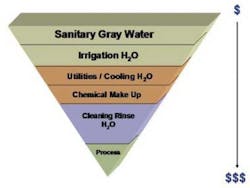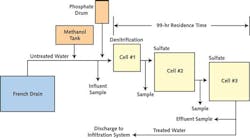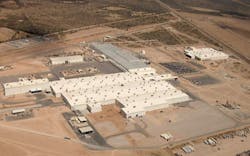The General Motors assembly plant in San Luis Potosi, Mexico, is situated in an arid, remote location, with no receiving stream or municipal sewer available to discharge wastewater. Lawrence Krzesowski, David Parker and David Adams discuss how a RO-based zero liquid discharge solution is maximising water reuse with minimal maintenance.
Following free oil removal, metals precipitation and biological treatment, water is softened in a multi-stage process using the proprietary high-rate chemical softening technology
For many years, zero liquid discharge (ZLD) has been regarded as an uneconomic solution for a number of manufacturing sectors. However, the growing scarcity of water in many areas has brought a sharper focus on the development of ZLD technologies in recent years, such that new, more cost-effective options are now available.
General Motors Corporation's recently built assembly plant in San Luis Potosi, Mexico, is the first zero liquid discharge plant in GM's history. The product water quality from the plant's water recycle system comfortably meets the effluent specification for total dissolved solids (TDS), making it reusable as process water for the assembly plant's paint processes and the transmission plant. The goal of the system to convert 90% of the tertiary wastewater into reusable water is also being achieved. Concentrated salts from the system are sent to on-site evaporation ponds.
Overview
The GM facility in San Luis Potosi treats raw water, high in dissolved silica, from limited-capacity deep wells to produce process and potable water for the manufacturing operations. The facility's process wastewater is generated by various automotive manufacturing operations, such as the electrophoretic paint system, phosphate lines, stamping plant, paint sludge system, transmission plant, and other process users. The wastewater contains high concentrations of dissolved metals, phosphates, free and emulsified oils, dissolved organics and silica.
At many automotive facilities, the pre-treated process wastewater is typically blended with the sanitary wastewater and discharged to a municipal wastewater treatment plant. Due to the arid, remote location, however, no receiving stream or municipal sewer is available near the San Luis Potosi site to receive wastewater generated by the plant.
With no municipal wastewater facilities in the area, an innovative option had to be determined before the plant went on-line. After review, N.A. Water Systems, a Veolia Water Solutions & Technologies (VWS) company, was selected to design and provide zero liquid discharge capabilities at the facility using its proprietary OPUS™ Technology. Crown Solutions, also a VWS Company, provided and installed the equipment for the project. A double-pass reverse osmosis (RO) to produce deionized water for the plant's paint operations was also provided.
Sizing Up The Challenges
Prior to the installation of the water recycle system, a key challenge in this project, carried out by GM/WFG Energy & Utilities Services, was to characterise all of the waste streams by conducting a comprehensive material balance throughout the entire plant. This included the paint shop, general assembly, the body shop and the transmission plant.
These major waste streams include heavy metals, such as nickel and zinc from the corrosion pre-treatment process of the paint line, as well as organic loading from the paint shop, transmission, machining and parts manufacturing lines.
The material balance determined how to best segregate the various streams for optimised treatment in the downstream recycle system. For example, oily waste from the transmission plant needed to be treated separately from the alkaline waste streams from the phosphate process. And periodic concentrated wastes from the paint shop also had to be segregated and treated.
Another important aspect of the design involved stabilising the composition of the wastewater treatment system streams, as well as the recycling system streams through equalisation and collection of "off-specification" wastewater, which was bled back into the normal wastewater at controlled flow rates. This resulted in reduced variability in the composition of wastewater feeding the recycle system.
Following this waste characterisation, process flow diagrams were created to determine the pre-treatment plan, which also included sizing the equipment and determining capacity. Process wastewater is pretreated for oil and grease and metals removal. It is then combined with the sanitary waste from the facility and treated by extended aeration activated sludge process for organics removal and total nitrogen.
The tertiary wastewater contains 2,000 to 3,000 mg/L TDS (total dissolved solids), 20 to 30 mg/L silica, and 30 to 40 mg/L of dissolved refractory organics. Following this pre-treatment, the tertiary wastewater is directed to two, 125-gpm two-stage reverse osmosis units to remove the TDS and dissolved organics so the water can be recycled for reuse.
The Recycle System
The treatment system was constructed to treat 30 m3/h of secondary treated wastewater and was designed to be modular so that future expansion could be easily achieved. Processes ahead of the RO stage are designed to eliminate or reduce the hardness, metals and suspended solids in the feed water. Total dissolved solids, including sodium and chloride, are targeted in the RO process.
Table 1: End-of-pipe treatment system feed water quality
Feed water (Table 1) is subjected to degasification with the addition of an acid to reduce the quantity of solids generated in the downstream chemical softening process and the alkali demand associated with raising the pH. The degasified water is then softened in a multi-stage process using the proprietary high-rate chemical softening and thickening technology, MULTIFLO™. Water from the chemical softening process is then directed through multimedia filtration, ion exchange softening, and cartridge filtration to further reduce the hardness, metals and suspended solids to lower concentrations without pH correction.
Success: the first zero liquid discharge plant in GM's history. The goal to convert 90% of the plant's secondary wastewater into reusable water is being achieved
Removal of total hardness and metals in the feed water eliminates the potential for scaling of the RO membranes due to calcium carbonate, calcium sulfate, calcium fluoride, barium sulfate, strontium sulfate, iron and manganese precipitates.
Following cartridge filtration, 125 gpm of the pre-treated water is pressurised through an RO system operated at an elevated pH in single pass mode to reduce the TDS present in the feed water. Operating the RO process at an elevated pH effectively controls biological, organic and particulate fouling, eliminates scaling due to silica, and increases the rejection of silica and organics. The reject water is sent to solar ponds at the site for evaporation. The RO product water is then pH adjusted with carbonic acid, then filtered through calcite filters to stabilise the re-use water prior to sending to the process users.
Performance and recovery rate
Through the system the GM plant has minimised liquid waste from the facility and the goal of the end-of-pipe treatment system - converting 90% of the secondary wastewater into reusable water, thus minimising the volume of liquid waste (<10%) generated for evaporation in solar ponds - is being readily achieved.
Even though the reuse process was designed with appropriate segregation of waste streams, there was still considerable variability in the feed water conductivity due to upstream upsets. However, the RO membranes remained stable throughout the operation of the plant, producing consistently high water quality suitable for reuse as process water for the assembly plant paint processes and the transmission plant.
Other General Motors facilities in Mexico have historically used hollow fiber microfiltration (MF) followed by RO to reuse the process wastewater and maintain sustainability. Results from other General Motors reuse facilities, on similar waste streams of pre-treated secondary wastewater, indicate that the maximum RO recoveries achievable with MF-RO pretreatment are in the range of 60% to 65%, with bi-weekly cleaning requirements to maintain production. The RO recovery limitations at these other facilities are primarily due to organic fouling, hardness, and silica scaling issues.
By comparison, at the San Luis Potosi plant's water recycle facility, the pre-treatment process ahead of the RO has shown to be very effective in the control of scaling, due to calcium and metal salts, and the elevated pH operation of the RO system has resulted in excellent control of organic fouling and silica scaling.
Finally, the low cleaning requirements on the RO system (once in four to six months) has substantially improved the system uptime availability, making OPUS technology a feasible and viable option for achieving high recoveries on high-fouling secondary wastewater reuse applications.
Implementing the OPUS system has allowed GM's San Luis Potosi plant to successfully pre-treat its mixed stream wastewater with minimal RO membrane fouling. Based on its experience with other RO-based systems, plant management had initially envisioned the necessity for major cleaning of the RO membranes of every three to four weeks. The water recycle plant has been in operation since October 2008 and received only one major cleaning over its first eight months of operation. WWi
Author's note:
More Water & WasteWater International Current Issue Articles
More Water & WasteWater International Archives Issue Articles





